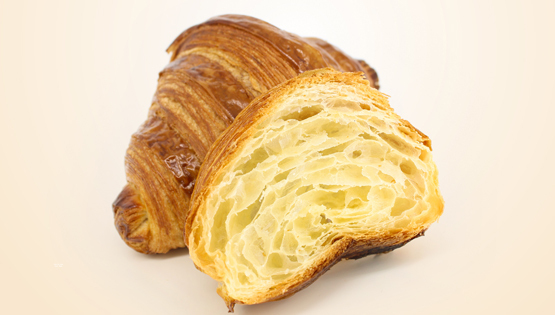Butter Croissants Recipe

Discover the secret to bakery-style butter croissants! From dough to baking, this easy recipe and premix make perfect croissants effortless.
 BAKE TEMP : 200°C
BAKE TEMP : 200°C
 MIXING TIME : 6 minutes
MIXING TIME : 6 minutes
 BAKE TIME : 2.5 - 3 hours
BAKE TIME : 2.5 - 3 hours
 PREP TIME : approx. 20 minutes
PREP TIME : approx. 20 minutes
Ingredients
Croissant 10 Concentrate – 100g
Refined Wheat Flour – 900g
Water (4°C) – 380g to 420g
Fresh Yeast / Dry Yeast – 40g / 15g
Unsalted Dry Butter (for lamination) – 500g
Butter – 80g
Sugar – 80g
Fresh Egg – 1, whole
NOTE: If making without egg, need to adjust the water percentage
Method
Croissant Dough Mixing
Place all the ingredients in a mixing bowl.
Using a spiral mixer, mix on low speed for 4 minutes until combined.
Increase to high speed and knead for an additional 2 minutes.
The croissant dough should reach a temperature between 16°C to 18°C.
Preparing Butter for Lamination
Place the unsalted butter between two sheets of parchment paper.
Pound it with a rolling pin until it is 1 cm thick and pliable.
Chill until firm.
Laminating the Croissant Dough
Roll out the dough into a rectangular shape with an even thickness of approx. 6mm.
Place the butter slab in the center of the rolled-out dough.
Fold the dough over the butter to encase it completely, ensuring there are no exposed edges.
Gently press the edges of the dough to seal in the butter.
1. Folding Variants for Laminated Croissant Dough
Variant A: 2 Double Folds (6mm thickness each)
Fold one third of the dough over the butter from the left side.
Fold the right side over this to completely encase the butter (first fold).
Roll the dough out again to a large rectangle, maintaining an even thickness of about 6mm.
Repeat the folding process by folding one third from the left and one third from the right (second double fold).
Chill the dough as required.
2. Variant B: 1 Single Fold (8mm thickness) + 1 Double Fold (8mm thickness)
Fold the left third of the dough over the butter and then fold the right third over it (single fold to 8mm thickness).
Chill the dough for a short period.
Roll the dough out again to a large rectangle, aiming for an 8mm thickness.
Perform a double fold by folding one third from the left and one third from the right, similar to a letter fold, maintaining an 8mm thickness.
Chill the dough as required.
3. Variant C: 3 Single Folds (8mm thickness each)
Fold the left third of the dough over the butter and then fold the right third over it (first single fold).
Chill the dough for a short period.
Roll the dough out again to a large rectangle, aiming for an 8mm thickness.
Repeat the single fold process by folding one third from the left and one third from the right (second single fold).
Chill the dough again.
Roll the dough out one last time to a large rectangle, maintaining an 8mm thickness.
Perform the final single fold by folding one third from the left and one third from the right.
Chill the dough as required.
Shaping, Proofing, and Baking
After completing the folding process, freeze the laminated dough at 4°C to 6°C for approx. 40 to 60 minutes.
Once properly chilled, take the dough out of the freezer and cut it into the desired shapes, typically triangular.
Roll the triangles from the base to the tip to form croissants.
Preheat the oven to 200°C.
Place the shaped croissants on a baking tray.
Allow them to proof for 30 to 40 minutes at 28°C under 75% relative humidity.
Glaze the proofed croissants with an egg wash for a golden, glossy finish.
Bake for approximately 20 minutes for 50g dough pieces, adjusting the time for different sizes.
This method ensures perfectly laminated, flaky, and buttery croissants suitable for any industrial baking.

